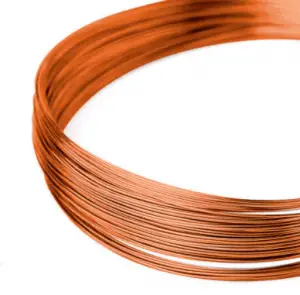High purity copper is a soft, malleable, and ductile metal with very high thermal and electrical conductivity. A freshly exposed surface of pure copper has a reddish-orange color. Copper is used as a conductor of heat and electricity, as a building material, and as a constituent of various metal alloys, such as sterling silver used in jewelry, cupronickel used to make marine hardware and coins, and constantan used in strain gauges and thermocouples for temperature measurement. High purity copper has the ultimate strength of approximately 210 MPa, and yield strength of 33 Mpa, which limits its usability in industrial applications. But similarly as for other alloys , copper may be strengthened. The main strengthening mechanism is alloying in Cu-based alloys.
Properties of Copper
Copper is a soft, tough, ductile and malleable material. These properties make copper extremely suitable for tube forming, wire drawing, spinning and deep drawing. The other key properties exhibited by copper and its alloys include:
- Excellent thermal conductivity. Copper has a 60% higher thermal conductivity rating than aluminium, so it is better able to reduce thermal hot spots in electrical wiring systems. The electrical and thermal conductivities of metals originate from the fact that their outer electrons are delocalized.
- Excellent electrical conductivity. The conductivity of copper is 97% that of silver. Due to its much lower cost and greater abundance, copper has traditionally been the standard material used for electricity transmission applications. However, aluminium is usually used in overhead high-voltage power lines because it has about half the weight and lower cost of a comparable resistance copper cable. At a given temperature, the thermal and electrical conductivities of metals are proportional, but raising the temperature increases the thermal conductivity while decreasing the electrical conductivity. This behavior is quantified in the Wiedemann–Franz law.
- Good corrosion resistance. Copper does not react with water, but it does slowly react with atmospheric oxygen to form a layer of brown-black copper oxide which, unlike the rust that forms on iron in moist air, protects the underlying metal from further corrosion (passivation). Copper nickel alloys, aluminium brass, and aluminium demonstrate superior resistance to saltwater corrosion.
- Good biofouling resistance
- Good machinability. Machining of copper is possible, although alloys are preferred for good machinability in creating intricate parts.
- Retention of mechanical and electrical properties at cryogenic temperatures
- Diamagnetic
Electrolytic-tough pitch (ETP) copper
 Electrolytic tough pitch copper, UNS C11000, is pure copper (with a maximum of 0.0355% of impurities) refined by electrolytic refining process and it is the most widely used grade of copper all over the world. ETP has a minimum conductivity rating of 100% IACS and is required to be 99.9% pure. It has 0.02% to 0.04% oxygen content (typical). Electrical wiring is the most important market for the copper industry. This includes structural power wiring, power distribution cable, appliance wire, communications cable, automotive wire and cable, and magnet wire. Roughly half of all copper mined is used for electrical wire and cable conductors. Pure copper has the best electrical and thermal conductivity of any commercial metal. The conductivity of copper is 97% that of silver. Due to its much lower cost and greater abundance, copper has traditionally been the standard material used for electricity transmission applications.
Electrolytic tough pitch copper, UNS C11000, is pure copper (with a maximum of 0.0355% of impurities) refined by electrolytic refining process and it is the most widely used grade of copper all over the world. ETP has a minimum conductivity rating of 100% IACS and is required to be 99.9% pure. It has 0.02% to 0.04% oxygen content (typical). Electrical wiring is the most important market for the copper industry. This includes structural power wiring, power distribution cable, appliance wire, communications cable, automotive wire and cable, and magnet wire. Roughly half of all copper mined is used for electrical wire and cable conductors. Pure copper has the best electrical and thermal conductivity of any commercial metal. The conductivity of copper is 97% that of silver. Due to its much lower cost and greater abundance, copper has traditionally been the standard material used for electricity transmission applications.
According to the Copper Development Association:
„The term ‘tough pitch’ originates from the time when molten copper, after refining, was cast into ingot moulds. During refining the copper was oxidised to remove impurities then reduced by hydrogen to give the correct oxygen level. To monitor this process, a small sample was taken and the solidification surface observed. If the surface sunk there was too much oxygen; if it was raised there was too much hydrogen. If it was level (correct pitch), the oxygen was correct, and the properties good; in other words ‘tough’, hence tough pitch.“
Source: https://copperalliance.org
Electrical Conductivity of Electrolytic-tough pitch (ETP) copper
The electrical conductivity of electrolytic-tough pitch (ETP) copper is 101% IACS (around 58.6 MS/m).
Electrical resistivity and its converse, electrical conductivity, is a fundamental property of a material that quantifies how strongly it resists or conducts the flow of electric current. A low resistivity indicates a material that readily allows the flow of electric current. The symbol of resistivity is usually the Greek letter ρ (rho). The SI unit of electrical resistivity is the ohm-metre (Ω⋅m). Note that, electrical resistivity is not the same as electrical resistance. Electrical resistance is expressed in Ohms. While resistivity is a material property, resistance is the property of an object.
We hope, this article, Electrolytic-tough pitch (ETP) copper – Electrical Conductivity, helps you. If so, give us a like in the sidebar. Main purpose of this website is to help the public to learn some interesting and important information about materials and their properties.